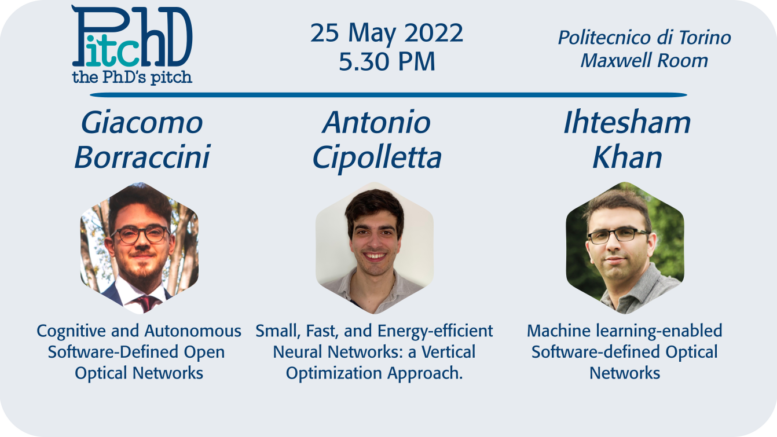25 May 2022 – 5.30 PM
Politecnico di Torino – Maxwell Room
Here’s the 4th PitchD – the PhD’s pitch. Our PhD IEEE Student Members explain to students, colleagues and professors their research in-presence. Please, remember that registration is required to attend the event.
Cognitive and Autonomous Software-Defined Open Optical Networks
Mr. Giacomo Borraccini
Dept. of Electronics and Telecommunications (DET), Politecnico di Torino
Driven by the increasing and greedy Internet data traffic request, optical network operators are working to satisfy this need, improving the already installed resources, or updating them thanks to the introduction of new technological discoveries. In this context, the most relevant support for service capacity increase and system management is conferred by optical network automation due to standardization and the consequent implementation of software-defined networks. Another important characteristic for an efficient usage of optical networks is the capability of the infrastructure to be agnostic with respect to the adopted vendor equipment, also favoring a more rapid deployment and integration of new functions. Definitely, this is allowed by hardware and software disaggregation, pushing in the direction of cognitive optical networks. Starting from the last decade, cognition has been introduced and theorized as an emerging feature of the next generation of optical networks. The response to the increasing complexity of the infrastructure is given by the possibility to probe the condition of the network through monitoring devices and to efficiently analyze the extracted information using flexible software modules. In this scenario, telemetry and monitoring devices cover a fundamental role, since they make it possible to retrieve information from the field to address different tasks and operations.
Small, Fast, and Energy-efficient Neural Networks: a Vertical Optimization Approach.
Mr. Antonio Cipolletta
Dept. Control and Computer Engineering (DAUIN), Politecnico di Torino
In the last few years, Neural Networks (NNets) have been used to beat the world champion in the game of Go and to achieve super-human accuracy in complex tasks, such as image classification and automatic language translation. The eagerness to adopt these powerful algorithms in a wide variety of applications with high user privacy, low latency, and low cost has recently required moving the NNets inference process from the cloud, powered by near-infinite resources, to “the edge”, that is, on lightweight resource-constrained embedded systems.
However, such a paradigm shift creates a tremendous technical challenge: filling the gap between the computational and memory requirements of modern NNets and the limited hardware and energy resources of embedded systems.
This talk will describe a vertical and automated approach to make NNets smaller, faster, and more energy-efficient.
Specifically, I will present several novel optimization techniques that push further the boundary of accurate NNets that can be deployed on tiny embedded devices.
Machine learning-enabled Software-defined Optical Networks
Mr. Ihtesham Khan
Dept. of Electronics and Telecommunications (DET), Politecnico di Torino
The fast growth in global optical network traffic and the advancement in the communication technologies, such as coherent optical transmission, elastic optical networks, and the introduction of software-defined optical networks, introduce many tunable parameters, making the design and operation of optical networks more complex. In this framework, exact system modeling using closed-form formulations is very challenging, and typically, a ‘margin’ is needed while adopting the analytical models. The deployment of such margins leads to the underutilization of resources and eventually enlarges the network operational cost. To cater this limitation of analytical models, the telecom industry is strongly pushing the optical community to move towards intelligent optical networks that can perform autonomous and flexible network management and optimize network resource utilization. This talk presents the basic framework of software-defined optical networks assisted by artificial intelligence in the direction of cognitive optical networks and demonstrates some used case applications.


